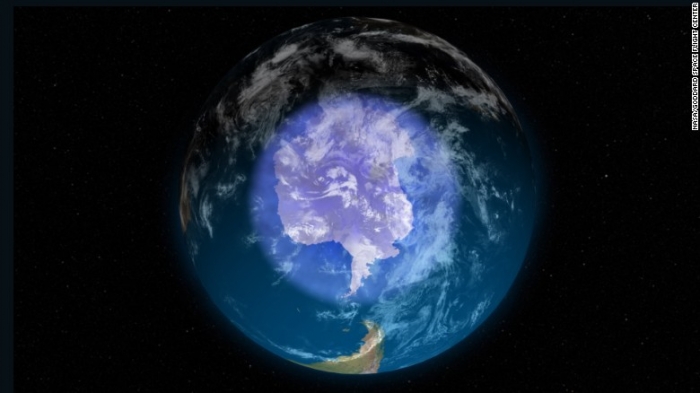Earth’s ozone hole is shrinking & is smallest it has been since 1988

Here's a rare piece of good news about the environment: The giant hole in the Earth's protective ozone layer is shrinking and has shriveled to its smallest peak since 1988, NASA scientists said.
The largest the hole became this year was about 7.6 million square miles wide, about two and a half times the size of the United States, in September. But it was still 1.3 million square miles smaller than last year, scientists said, and has shrunk more since September.
Warmer-than-usual weather conditions in the stratosphere are to thank for the shrinkage since 2016, as the warmer air helped fend off chemicals like chlorine and bromine that eat away at the ozone layer, scientists said. But the hole's overall reduction can be traced to global efforts since the mid-1980s to ban the emission of ozone-depleting chemicals.
“Weather conditions over Antarctica were a bit weaker and led to warmer temperatures, which slowed down ozone loss,” said Paul A. Newman, chief Earth scientist at NASA's Goddard Space Flight Center in Maryland. “It's like hurricanes. Some years there are fewer hurricanes that come onshore . . . this is a year in which the weather conditions led to better ozone [formation].”
The news comes just after the 30th anniversary of the hole's discovery, which led to the 1987 Montreal Protocol — a landmark international agreement that led to major global efforts to phase out the use of ozone-depleting chemicals.
Deterioration of the ozone layer was mainly taking place over Antarctica, and became a particular cause for concern for those living in the southern hemisphere. Ozone, a colorless gas, protects the Earth from harmful ultraviolet radiation, which could cause higher rates of skin cancer and cataracts disease, as well as disrupt plant growth, scientists say.
Scientists first realized chlorofluorocarbons were wearing down the thin ozone layer above Antarctica in the 1970s. From the mid-1980s and through the 1990s, the ozone hole became a worldwide sensation, with frightening connotations that led the public to support scientists' battle against its growth.
The public feared scientists' well-being at the South Pole, wondering if they would be burned by ultraviolet radiation while studying the hole that would blind them or damage their skin. Increased fears of skin cancer and the ozone hole further deteriorating spurred 24 nations to sign the Montreal Protocol upon its formation. That number eventually rose to 197.
It was a rare scientific agreement, scientists say, because it did exactly what it was supposed to do: galvanize action toward closing the hole in the ozone layer. Thursday's findings show the world is on track toward doing just that.
“It's extremely rewarding, because it was originally just a scientific effort, and then we were able to convince society that it was a problem — here's what would happen if we do not deal with it,” said chemist Mario Molina, who had an integral role in the discovery of the ozone hole and who was awarded a Nobel Prize for his research in 1995.
In 2014, scientists at the United Nations credited the recovery of the ozone layer to the phasing out of chemicals used in refrigerators, air conditioners and aerosol cans in the 1980s. But chlorofluorocarbons have long lifetimes, and could still float around in the atmosphere 100 years from now, Newman said. Scientists predict the ozone layer won't return to its 1980s form until about 2070, he said.
In June, scientists identified a possible threat to the recovery, believing dichloromethane — an industrial chemical with the power to destroy ozone — doubled in the atmosphere over the past 10 years. If its concentrations keep growing, it could delay the Antarctic ozone layer's return to normal by up to 30 years, according to the study published in the journal Nature Communications.
The ozone hole was largest in 2000, when it was 11.5 million square miles wide, according to NASA.
The original article was published in the Washington Post.















































